Role Of Systemic Diseases In The Etiology Of Periodontal Disease Important Notes
1. Vitamin deficiency and periodontal manifestations
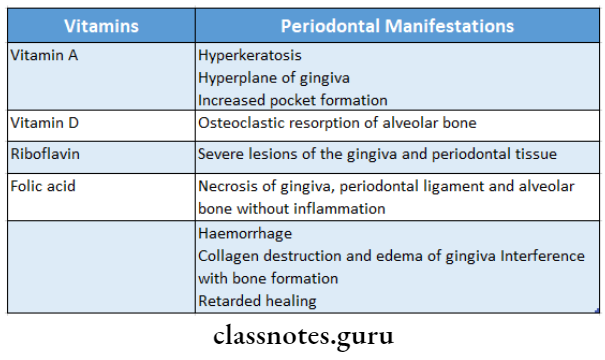
Role Of Systemic Diseases In The Etiology Of Periodontal Disease Short Essays
Question 1. Role of nutrition in Periodontal diseases.
Answer:
- Essential nutrients are required for the maintenance of healthy periodontium
- They must be present in balanced quantities
- Its deficiencies may cause adverse effects on the periodontium
Read And Learn More: Periodontics Question and Answers
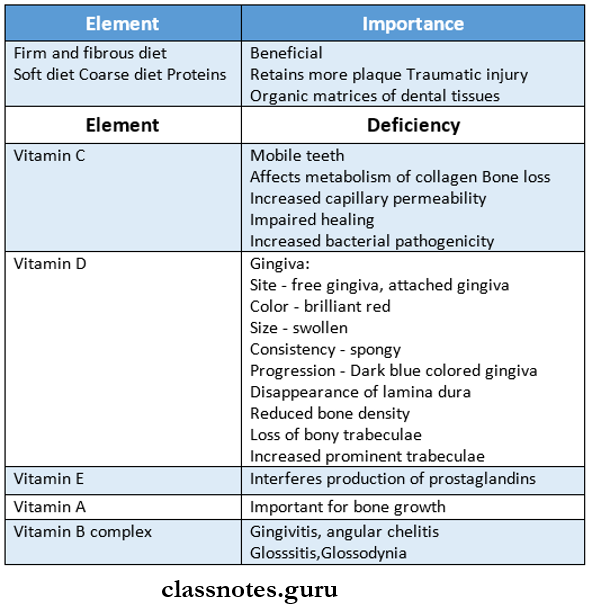
Question 2. Periodontal management in Renal Transplant Patient.
Answer:
- Consult physician
- Monitor blood pressure
- Laboratory Investigation
- Bleeding time
- Prothrombin time
- Screen for hepatitis B
- Provide antibiotic prophylaxis
- Eliminate the source of infection on the day after dialysis
- Frequent recall visit
- Avoid administration of the nephrotoxic drug
- Dental planning must be done to decide whether Essential, biologically active constituents tain/extract teeth
- Teeth with furcation involvements, periodontal abscess, and extensive surgical requirements should be extracted
- Use of oral antibiotic mouthwash with nystatin
Question 3. Infective Endocarditis.
Answer:
Infective Endocarditis is a disease in which micro-organisms colonize the damaged endocardium/heart valves
Types of – Acute and sub-acute
Organisms involved – Streptococci, Staphylococci
Preventive Measures:
- Define susceptible persons
- Provide oral hygiene instruction
- Antibiotic prophylaxis
- Endodontic therapy instead of extraction
- Elimination of source of infection
- Avoid prolonged impingement on gingival tissues by retraction
- Rinse with 0.12% chlorhexidine prior to surgery
- Regular recall visits
Question 4. Antibiotic prophylaxis for medically compromised patients.
Answer:
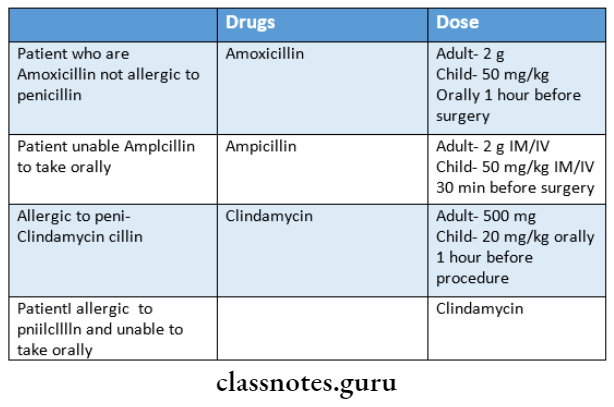
Question 5. Vitamin C and periodontal disease.
Answer:
Periodontal disease Vitamin C:
- The essential, biological active constituent
- Water soluble vitamin
Periodontal disease functions:
- Vitamin C helps in tissue oxidation
- It is needed for the formation of collagen
Periodontal disease Deficiency: Scurvy
Periodontal disease Features:
1. General:
- Increased susceptibility to infection
- Increased capillary permeability
- Impaired wound healing
- Sluggishness of blood flow
2. Oral – Gingiva:
- Involved site – Free gingiva and attached gingiva
- Size – Increased
- Color Brilliant red
- Consistency-spongy
- Symptom – Tender, bleeding gums
Periodontal disease others:
- Defective osteoblastic formation
- Decreased bone formation
- Impaired bone removal
- Results in bone resorption and tooth mobility
Role Of Deficiency Of Vitamin C:
- Influence the collagen metabolism
- Affects tissue regeneration and repair
- Interferes with bone remodeling
- Allows passage of pathogens due to increased capillary permeability
- Increases bacterial pathogenicity
Question 6. Diabetes mellitus and periodontal disease.
Answer:
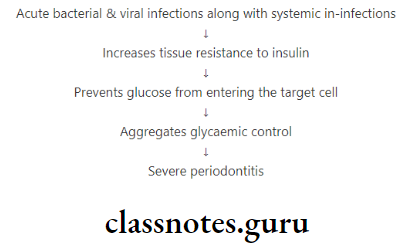
Periodontal disease Pathogenesis:
1. Vascular changes:
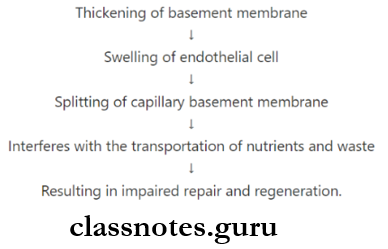
2. PMN”s function: Impaired adherence, phagocytosis, and intracellular killing
3. Crevicular fluid: Reduced cyclic AMP levels
4. Microflora: Reduced hyaluronidase activity
Diabetes And Periodontal Treatment:
- Periodontal therapy decreases pathogens thereby inflammation
- Results in improved metabolic control
Alterations In Treatment Plan:
- Morning appointments
- Altered post-operative dose
- Atraumatic procedure
- Antibiotic prophylaxis
Question 7. Periodontal therapy for pregnant women.
Answer:
1. Plaque control:
- Reinforce oral hygiene techniques
- Scaling, polishing, and root planning may be performed whenever necessary
- Avoid the use of high alcohol content antimicrobial rinses
2. Elective dental treatment:
- Avoid during 1st trimester and the last half of 3rd third semester because
- First trimester- period of orga
- Third trimester-risk of premature delivery
- Avoid prolonged chair time
- The pregnant patient is allowed to turn on her left side frequently to remove pressure on the vena cava Second trimester is the safest period
- Major surgery should be postponed until delivery
3. Dental radiograph:
- Avoided protecting the fetus from radiation
- If necessary radiographs are taken along with a protective lead apron
4. Medications:
Medications Safe Antibiotics:
- Penicillin Erythromycin
- Clindamycin
- Cephalosporin
Medications Contraindicated Antibiotics:
- Tetracyclines
- Ciprofloxacin
- Metronidazole
- Clarithromycin
Question 8. Periodontal infection is a cause of atherosclerosis.
Answer:
- Products, calcium, and other substances accumulate in the blood vessel wall forming plaque that elevates into the blood vessel blocking the blood flow
- The ruptured plaque fragments can release certain pro-coagulant chemicals that may cause platelet aggregation and in turn cause thrombus formation
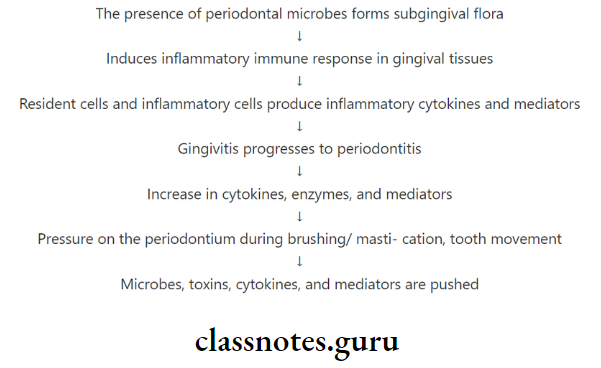
- They travel to distant sites and initiate pathology specific to that organ/system
- Periodontitis influences atherosclerosis by
- Microbes like Streptococcus samurais and P. gin- gives release platelet aggregation associated protein and aggregate platelets leading to thromboembolic events
- Direct invasion of periodontal pathogens
- Presence of periodontitis
- Action of macrophages
Role Of Systemic Diseases In The Etiology Of Periodontal Disease Short Question And Answers
Question 1. Pregnancy gingivitis.
Answer:
Occurs during the first trimester of pregnancy
Pregnancy gingivitis Changes:
- Mushroom-like flattened spherical mass
- Protrusion from interdental papilla occurs
Pregnancy gingivitis Causes:
- Aggregation of previous inflammation
- Altered tissue metabolism
Pregnancy gingivitis Features:
1. Gingiva:
- Marginal and interdental gingiva is edematous, pits on pressure
- Color- bright red or magenta
- Consistency- Sof and friable
- Bleeding on probing is present
- Size- increased
- Loss of stippling
- Shape- mushroom-like flattened spherical mass
- Increased GCF
2. Other features:
- Increased susceptibility to mechanical irritation
- Increased GCF
- Increased pocket depth
- Increased mobility
- Depression of maternal T-lymphocyte response
Question 2. Periotemp.
Answer:
- It is a probe used to detect pocket temperature differences of 0.1 degrees C from the reference temperature
- The temperature gradient exists between maxillary and mandibular teeth and between posterior and anterior teeth
- Individual temperature differences are compared
- Higher temperature pockets are signaled with a red-emitting diode
- Periotemp is also used to identify loss of attachment
- Red temperature indicates twice the risk of attachment loss
Question 3. Biopsy.
Answer:
Biopsy Uses:
- Rule out malignancies
- Detect local and systemic inter-relationship
- Differentiate among different types of gingival enlargements
- Helpful in the presence of desquamative gingivitis
Specimens Obtained Are:
Marginal and attach gingiva
Question 4. Periodontal care in patients with anticoagulant therapy.
Answer:
- Consult the physician
- To stop aspirin 7-14 days prior to surgery
- Minimize trauma
- Prophylactic antibiotics
- Use pressure hemostasis
- Complete stoppage of bleeding prior to placement of the periodontal pack
- Avoid therapy if the patient has an acute infection
- Recall after 3-5 days
Question 5. Stress and periodontal diseases.
Answer:
- Stress may induce periodontal diseases in the oral cavity through
- Development of habits that are injurious to the periodontium
- Poor oral hygiene
- Poor nutritional intake
- Overeating of high-fat diet due to stress
- All of the above increases susceptibility to bacterial infection and leads to periodontal diseases
Question 6. Periodontal care of patients with tuberculosis.
Answer:
- The patient with tuberculosis should receive only. emergency care
- If the patient has completed chemotherapy, the patient’s physician should be consulted regarding ineffective- city and results of sputum cultures for M. tuberculosis
- When medical clearance has been given and sputum culture results are negative, these patients may be treated normally
- Adequate treatment of tuberculosis requires a minimum of 18 months and thorough post-treatment follow-up should include chest radiographs, sputum cultures, and a review of the patient’s symptoms by the physician at least every 12 months.
